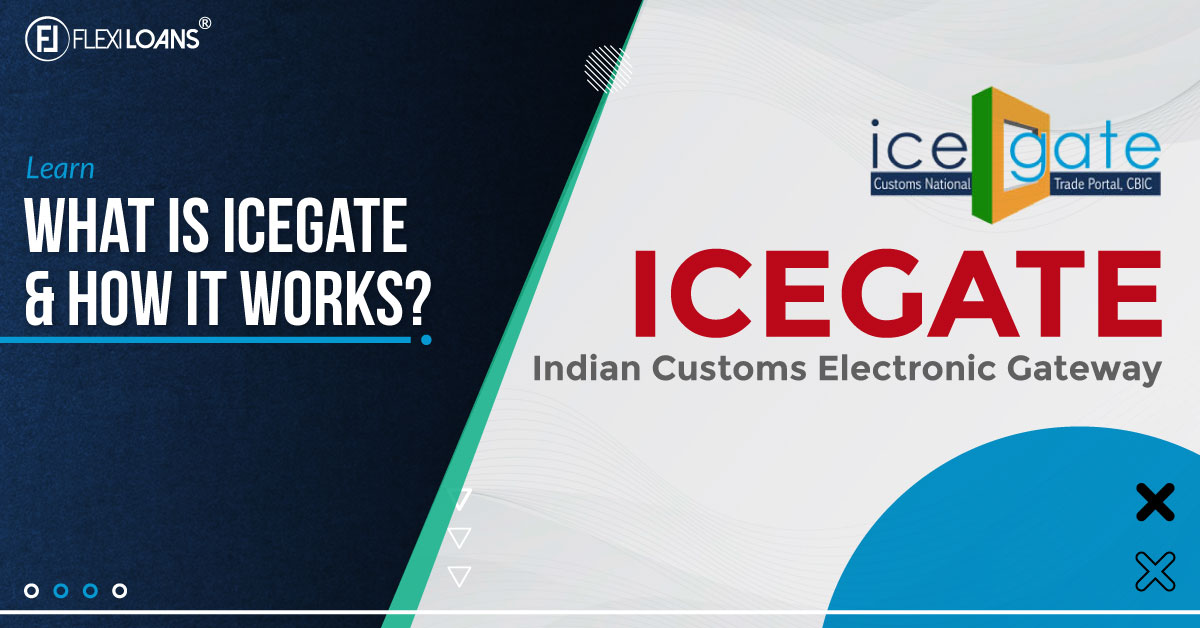ICEGATE – What is ICEGATE, How Does it Work, Bill of Entry, Shipping Bill
May 12, 2023

What is ICEGATE?
The ICEGATE stands for “Indian Customs and Central Excise Electronic Commerce/Electronic Data Interchange (EC/EDI) Gateway.” It is a government-created internet platform that makes e-commerce trading possible.
It also helps share electronic data related to customs clearance, import, and export processes. It is a single-window platform that allows shareholders to access information 24 hours a day, seven days a week.
Meaning and Scope of ICEGATE:
ICEGATE aims to help importers, exporters, and customs brokers gain easy access to various e-services. These include e-payment of customs duty, shipment tracking, import/export report filing, and customs clearance.
Tariff and duty calculators, risk management systems, and electronic message exchange services are also a part of the services provided by the ICEGATE portal. These ensure that traders obey customs needs.
This software has greatly reduced the time and expenses related to customs clearance functions. It has also improved the general efficiency of India’s international trade. This has also promoted more traders to aim to go global. ICEGATE makes it easier for you to take your business to the next level.
ICEGATE supports a wide range of customs-related processes and services. ICEGATE’s primary services include:
- You can file customs paperwork such as bills of entry, shipping bills, export declarations, and import/export permits electronically.
- You can pay customs duties and any applicable charges online.
- It updates the status of shipments in real time.
- It involves a variety of parties in the trade process. Importers, exporters, customs brokers, shipping companies, and other government organisations are a part of it.
- Stakeholders can share information among themselves using an online chat system.
- Importers and exporters can register online.
- Customs officers and other shareholders can exchange documents and information online.
- It connects with many more government organisations, such as the Central Board of Excise and Customs, the Directorate General of Foreign Trade, and the Reserve Bank of India.
The overall goal of ICEGATE is to improve customs clearance processes, decrease the time and expenses of international trade, and increase the ease of the trade process overall.
Registering for ICEGATE
The Indian Customs Department operates the e-commerce platform ICEGATE (Indian Customs Electronic Commerce/Electronic Data Interchange Gateway). It offers an exclusive online window to submit business-related documents and pay customs duties and taxes.
To submit paperwork related to customs over the Internet, importers and exporters in India must use ICEGATE. The ICEGATE registration process is easy and the software provides you with information on each step.
Steps to follow to register on ICEGATE:
You can follow the below steps to register with ICEGATE:
Step 1: Start by visiting the official ICEGATE website (www.icegate.gov.in)
Step 2: Then click on the “Signup” link. Sign up on this site to register.
Step 3: Enter an ICEGATE ID and your email ID. You can also check the availability of ICEGATE IDs. These follow the criteria of the portal.
Step 4: To sign up as a CHA Licence / F Card Holder, select “Custom Broker or CHA” from the “User Role drop” down.
Step 5: Select the “Licence Holder/F Card Holder” from the “User Type” dropdown. Enter the “CHA PAN No.” and click the verify button.
Step 6: Confirm your details by clicking the “Confirm” button.
Step 7: Select the “Photo ID Type” from the dropdown. Click the “upload DS” link to upload Digital Signature. Select the “Certificate Name” and click the “OK” button. Click “OK” again for validation status.
Step 8: You will get a pop-up that says, “Digital certificate has been verified successfully”- Click the “OK” button.
Step 9: Check the “Terms and Conditions” check box and click the “Confirm” button.
Step 10: On the next page, enter the “OTP” and click the “Submit” button. You will then receive a new page with the registration confirmation message.
In the same way, you can register as a CHA G card holder, IEC holder, IEC Authorised Person, Air Line/Console Agent/Shipping Line/Shipping Agent, and Custodians.
Documents Required to Register on ICEGATE
You must submit the following documents, depending on your user type, to register on ICEGATE (Indian Customs Electronic Commerce/Electronic Data Interchange Gateway):
- PAN (Permanent Account Number) card
- Bank details (Cancelled cheques or statements)
- Digital signature certificate (DSC) and class-3 certificate
- Import Export Code (IEC) certificate
- Proof of a business or trade, such as a trade license, registration document, or GST registration document.
- Identity proof and address proof of the authorised person (if the importer is not an individual)
- Authorised signatory details and a copy of their photo ID (such as PAN card, Aadhar card, passport, or driving license).
- CHA License issued by Customs
- Bank certificate of the CHA firm
- Authorisation letter (if the Customs House Agent represents the exporter)
Benefits of Using ICEG
Trade and cargo carriers may benefit from using ICEGATE (Indian Customs Electronic Commerce/Electronic Data Interchange Gateway) in several ways. Here are a few of the main advantages of using ICEGATE:
- Faster clearance: Officials can paperlessly check customs documents via ICEGATE, reducing the time it takes to clear imports and exports. The system also offers an option for online payment of duty, tax, and fee payments.
- 24/7 access: Users of ICEGATE can submit their customs documents and check the status of their shipments whenever they want from anywhere because it is accessible 24 hours a day, seven days a week.
- Cost savings: Using ICEGATE, users can save money because they no longer need to submit physical customs documents, and managerial work reduces.
- Improved accuracy: Users can file customs paperwork on ICEGATE digitally, which reduces input mistakes and mismatches that manual data entry may cause. It produces accurate and consistent data.
- Transparency and accountability: With the help of ICEGATE, there are fewer chances of corruption and fraud in the customs clearance process.
- Real-time information: ICEGATE allows consumers to follow their shipments at every stage and offers real-time data on the progress of customs clearance.
Using ICEGATE helps ease and simplify the customs clearance process, cutting down on time and expense while sticking to customs laws.
ICEGATE Bill of Entry
Indian Customs Electronic Commerce Gateway, or ICEGATE, is an internet gateway created by the Indian Customs. It makes it easier to file customs-related paperwork online and conduct online deals. ICEGATE helps submit the Bill of Entry, which is one of the important documents.
To get their imported goods cleared through customs, an importer or a customs clearance agent must present a legal document known as the Bill of Entry to the customs authorities. It is possible to track a Bill of Entry (BOE) through ICEGATE.
It includes information like the importer’s name and address, the description and cost of the items being imported, the country of origin, the number of goods, the value of goods, the amount of customs duty, and other relevant details.
The following information forms a part of the ICEGATE Bill of Entry:
- Port Code
- Licence Number
- Customs House Agent Code (CHA)
- Importer’s name
- Importer’s address
You must have a working ICEGATE login ID and password to submit a Bill of Entry using the platform. Next, you can choose the ‘File Bill of Entry’ option from the menu and enter the necessary information.
The system generates a unique ICEGATE Bill of Entry number, which will be printed and given to customs authorities with other required papers. Once you submit, the ICEGATE Bill of Entry goes through several processing steps, including duty calculation, product inspection, and verification of documents. You can also download a soft copy of the bill of entry from the ICEGATE portal.
You can use the unique Bill of Entry number to track the ICEGATE Bill of Entry status through the ICEGATE site. You must ensure that the Bill of Entry is correctly and precisely filled out, as any errors or omissions could delay the clearance of the goods and result in fines. This Bill of Entry can be tracked by customs as well as traders through ICEGATE.
ICEGATE Shipping Bill
The most important document for receiving clearance from customs officials is the ICEGATE shipping bill. A shipping bill is a document that includes details of the products leaving India. It contains information like:
- Exporter’s name and address
- The receiver’s name and address
- Mode of transport
- Description of the products
- Their number and value
- The port of destination.
The shipping bill must also include all of the sender’s tax details. As a result, it is simpler to claim duty-related fines, additional charges, and duties. Shipping bills form part into categories such as:
- Free Shipping Bills
- Dutiable Shipping Bills
- Drawback Shipping Bills
- Shipping Bills for Shipment Ex-Bond
- Coastal Shipping Bills
These are based on the duty drawback and customs duty. With the help of shipping bill tracking, exporters and merchants can monitor the clearance status for various goods via the ICEGATE website.
You can track a shipping bill on the website by selecting the destination and entering the required information, including the date and shipping bill number.
Shipping Bill Tracking
To get customs clearance, the exporter must present a special bill called a shipping bill tracking. You must note that a person needs a shipping bill to load the items. Therefore the exporter needs to provide one.
On the ICEGATE portal, the exporter must submit the shipping bill online. The exporter may, however, also submit a physical shipment bill, but before that, he must get permission from the Principal Commissioner or commissioner first.
Export Shipping Bills
Export shipping bills come in varieties; you can tell them apart by their colours. The following are the several types of shipping bills, as well as the colours that show them:
| Sr. No. | Name of the form of the bill | Colour |
| 1. | Goods that are subject to customs duty | Yellow |
| 2. | Goods that are not subject to customs duty | White |
| 3. | Goods with drawback claims | Green |
| 4. | Goods included in the DEPB (Duty Entitlement Pass Book) Scheme | Blue |
| 5. | Goods that one can export duty-free and out of bond | Pink |
ICEGATE Shipping Bill Procedure
A shipping bill must be provided once the officials grant the vessel, ship, etc., permission to leave the country. After submitting the bill, the customs officials inspect it to determine the value of the goods. Customs authorities clear the copy of this shipping bill with the words “let export order” and “let ship order” after they verify it.
Procedure to Generate ICEGATE Shipping Bills
Here’s the process to generate a shipping bill and how you can download the shipping bill from ICEGATE:
- To create a shipping bill number format, the exporter must have the items below.
- IEC Code No. or Customs House Agents (CHA) license number
- Bank account number, which will transfer the export revenues using the Authorised Dealer Code.
- Along with the invoice and a copy of the packing list, the exporter or his customs house agents must sign the declaration and bring it to the service centre.
- When data entry is complete, the exporter must validate the data using the checklist and then report the results to the service centre. If the data is accurate, the centre processes it automatically.
- If applicable, the Assistant Export Commissioner will evaluate the processed data,
- If the value of such shipment exceeds 10 lakh Indian rupees, or
- If the cost of free samples exceeds 20,000 Indian rupees or
- If the drawback amount is more than 1 lakh Indian rupees
- After completing the steps mentioned above, the exporter can use the service to check the status of the shipping bill.
- If a question arises, the exporter must respond as soon as possible by giving the service centre his information.
- Before exporting the goods, the exporter must provide a checklist and all original paperwork, including the invoice and packing list.
- Exporters may produce the shipping bill if they obtain a “Let Export Order.”
Through ICEGATE, a trader can search the status of their shipping bill. Through FlexiLoans’ advanced technology system, you can track the progress status of your loan. Our team is always eager to help you with more information or any step in the application process.
What is IGM in Shipping?
In shipping, IGM stands for “Import General Manifest”. An IGM is a legal document that the carrier of the goods fills out at the destination customs facility. Import General Manifest (IGM) is an essential document that the trader must show to the customs officers at the destination port when importing goods.
It includes information about each shipment of cargo or merchandise arriving in a country on a certain vessel. The following information forms part of the Import General Manifest:
- IGM Number
- Line Number
- Importer’s name
- Importer’s address
- Description of goods
- Port of loading
- Other relevant details about the goods
How Does IGM Work?
The customs officers will verify the data listed in the documents mentioned above. The IGM declares that the cargo has arrived at its destination. Since you must fill out this form whenever goods arrive at a destination, there is no way for you not to do it.
As soon as imports arrive at the customs station, each nation’s government requires carriers to complete the Import General Manifest (IGM).
- Each line of the bill of lading or airway bill containing import information comes with a serial number that forms a part of the Import General Manifest (IGM).
- Once done, the importer must submit the required Bill of Entry based on the Import General Manifest. This takes place to ensure that the carrier meets all the rules and protocols for import customs clearance.
- After that, officials manually enter data into the system because there aren’t any electronic filling machines at customs facilities. To do this, you will see a customs agent filling out the questionnaire and ensuring they record every piece of data needed for the Import General Manifest (IGM).
- If they find any mistakes when completing the Import General Manifest, you must know that the import customs facility will not accept clearance papers. All the information in the Import General Manifest’s details must match that in the Import Customs Clearance paperwork.
Attachments to be Sent with IGM
You must present to the IGM the following supporting documents according to governmental regulations:
- Deck Cargo certificate / Declaration
- Income tax certificate (for export cargo)
- The last copy of the port clearance document
- Amendment application (if any)
- A ‘No Demand’ certificate from the Port Trust
- Certificate for nil export cargo
- Crew baggage checking application
- Sign on/off application for the crew (according to relevancy)
What is EGM?
An important counterpart of IGM is EGM. In the context of shipping, EGM stands for “Export General Manifest”. It is a document that lists every cargo item being exported on a specific vessel. The person in command of the ship or the aircraft is responsible for filing the EGM.
The agent of the person in charge may also carry out this function, according to Section 148 of the Customs Act. These people should identify themselves as agents and have the proper authorities confirm their status as such. They will then be responsible for carrying out the duties of the person in charge and for any legal outcomes, such as fines and seizures.
The Customs Act of 1962 places various obligations on carriers to ensure efficient control over exports and imports. One such duty that falls to the carrier is the Export General Manifest (EGM).
EGM Process:
To complete the customs clearance process, the person in control of the cargo vessel or aircraft must provide information about the shipment loaded onto them in a prescribed format. You must fill out an EGM before the carrier departs. Details that the EGM includes are:
- The name of the ship
- Its arrival and departure dates
- Exporter’s name
- Description of the goods
- Number of packages
- Weight of packages
- Value of the cargo
The customs officials use this information to verify the accuracy of the export declaration and that the exporter has fulfilled all legal needs.
The EGM certifies export reports for customs officials. The exporter can claim the advantages of the exports only based on these certificates. The EGM ensures that every item that leaves India’s territorial waters and borders is properly accounted for.
The EGM appears according to the Export Manifest (Vessels) Regulations of 1976 and the Export Manifest (Aircraft) Regulations of 1976. Duplicate export manifests are necessary, and each must list all the goods transported on the aeroplane or vessel in compliance with these criteria. There are four EGM forms in total:
- Form I contains a general declaration
- Form II includes the passenger manifest
- Form III, in the case of vessels, contains a list of the private property that the master, officers, and crew own, and in the case of aircraft, Form III provides the cargo manifest.
- In the case of aeroplanes, the airline files a separate Form IV with the list of the captain’s and crew members’ private property.
Also, in the case of an aircraft, the cargo manifest will detail (on separate sheets) the cargo that the trader has shipped, transhipped, and is currently in the craft but has not yet landed or transhipped.
Each of these three categories requires you to complete a separate form if you transport items like weapons, ammunition, explosives, narcotics, dangerous drugs, or gold.
Difference between IGM and EGM
| Key Difference | IGM | EGM |
| Meaning | IGM in shipping means Import General Manifest. | EGM in shipping means Export General Manifest. |
| Purpose | The IGM assists in making sure that a vessel’s import cargo has been reported in full and that the carrier has complied with all legal requirements. | EGM ensures that every item the exporting nation leaves is properly accounted for. |
| Who should file | The carrier, or their agent, files an IGM with the destination country’s customs authorities. | Whereas EGM forms a report to the origin country’s customs authorities by the carrier or their agent. |
| Details | IGM forms a part of imports. Hence it contains details about the items entering a country on a certain vessel. | EGM forms a part of exports. Hence it comprises details about the items that are leaving a country on a specific vessel. |
| Information included | IGM contains information about the importer, the items’ description, the number of packages, the weight, and the cargo’s worth. | Whereas EGM contains information like the exporter’s name, the products’ descriptions, the number of packages, the weight, and the value of the cargo. |
| Legal responsibility | The accuracy and completeness of the information in IGM are legally the carrier’s or their representative’s responsibility. | While the legal responsibility for the accuracy and completeness of the information in EGM rests with the exporter or their representative. |
What is Consol Manifest?
Another essential document a trader needs to have alongside the IGM and EGM is the Consol Manifest. The term “consolidated manifest,” often known as a “consol manifest,” refers to a document you use in shipping to detail all of the cargo you transport on a single vessel. It is a summary of each bill of lading, which are individual records that detail the specific goods sent out.
When the items arrive at customs, the freight forwarder co-loading any cargo must have a consol manifest ready to be submitted. Based on such a console manifest, the importer submits import documents to complete the clearing process to receive the products.
The consol manifest is an important document for the shipping company and the customs officials who inspect the cargo at the port of arrival.
Contents of a Consol Manifest
The Consol Manifest contains:
- Operator name and details
- Consignor Information
- Bill of Lading number
- Details relevant to the goods (quantity, type, and description of goods)
- Consignee Information
- Shipping route
- Information about freight charges
- Costs associated with the shipment.
Usually, the carrier, the agent, the shipper, and its agent sign the consol manifest to confirm that they understand the terms and conditions.
Who Uses the Consol Manifest?
While all parties interested in the cargo carried by the ship need the cargo manifest, it is most important for port customs. They need it so the ship can release its cargo at the port.
- The ship’s commanding officer is in charge of giving the port customs the consol manifest.
- The chief officer, who is also known as the first mate, is in control of the ship’s cargo. He is responsible for the loading, unloading, stowing, and lashing of the cargo.
Even if the cargo heads to multiple locations, the normal cargo manifest details every item on board. Most of the time, it also shows the price of each item. The list uses the items loaded from each port of call and the bills of lading.
As each shipment arrives at its destination port, the cargo ship’s first mate or chief officer can easily cross items off the list. The shipping firm and the customs inspectors, who examine the cargo at the port of arrival, need the consol manifest.
It helps make sure that everything on board is present and in working order and that all fees and taxes are up to date. It also enables the shipping company to monitor the cargo’s progress and guarantee that its journey is safe and it reaches its destination on schedule and in good shape.
Start your journey to expansion today with FlexiLoans. Online Business Loan from FlexiLoans have a quick approval rate and a status-tracking feature that lets you monitor the progress of your loan application. So you can be fearless about any delay in collecting the finance you need for your next step.
What is a Bill of Lading in Shipping?
A bill of lading is a crucial document that serves as a contract between the captain, an agent of the carrier firm, or the owner of the carrier issues. It offers a record of the items being sent, their amount, and their delivery conditions. Typically, the importer uses the bill of lading to submit the bill of entry.
A bill of lading works as proof for the carriage contract. It acts as proof of ownership of the commodities and serves for several tasks, including obtaining financing, setting up insurance, and releasing the items at the port of destination.
There are three main types of bills of lading, as mentioned below:
- Straight bill of lading: This kind of Bill of Lading is non-negotiable, which means it is non-transferable to another party and only valid for the named consignee.
- Order bill of lading: This kind of B/L is negotiable, which indicates that it may be sent to a different party with an endorsement or in other ways.
- Bearer bill of lading: This kind of B/L is negotiable and can be sent to a different party to transfer ownership.
The bill of lading is a key document in international trade, and efficient cargo transportation depends on its correct and prompt issuing.
Here at FlexiLoans, we have always believed in the potential businesses hold. This is why we have a range of MSME loan that will suit your business needs.
FlexiLoans aims to help fund a businessman’s every need. Whether starting a business or expanding your existing one, FlexiLoans is your choice. Competitive interest rates and a flexible repayment system are some of our specialties.
Go to our business loan page to better understand FlexiLoans’ loan options, and they can help you. Take that next step in your business. We are with you!
FAQs
Q. 1 Who can use ICEGATE?
Ans: Authorized importers, exporters, customs brokers, shipping agents, and other organizations involved in trade may use ICEGATE.
Q. 2 Why do I have to sign up for ICEGATE?
Ans: Online document filing is only possible for registered users. Therefore, one must have a registered ICEGATE ID to fill out online shipping bills, bills of entry, and other documents.
Q. 3 Which transaction types does ICEGATE support?
Ans: You can register on ICEGATE for transaction types, including Import, Export, Import General Manifest, Export General Manifest, and Consol Manifest. You can use ICEGATE for other things, like checking for updates or changing your ICEGATE Bill of Entry or Shipping Bill.
Q. 4 How do I find the status of my shipment on ICEGATE?
Ans: You must input the shipping bill number or bill of entry number in the tracking section of the ICEGATE website to track your shipment there. The mobile app also allows you to keep track of the progress of your shipment.
Q. 5 What is a Customs Duty?
Ans: A customs duty is a tax a government imposes on goods brought into a country from outside. It’s also referred to as import duty or tariff. The value of the items a trader transports across international boundaries determines how much officials charge him.
Customs duties have several functions. These include protecting domestic businesses from foreign rivalry, bringing in money for the government, and controlling the movement of products across borders. Sometimes, you don’t have to pay as much tax on the goods you bring in depending on their usage, for example, if it’s for personal use or research.
Customs duties can also be a penalty for breaking the rules by smuggling or misidentifying products.
Q. 6 Can I pay Customs duty online?
Ans: Yes, you can pay the customs duty online. This is possible with the help of the ICEGATE (Indian Customs and Central Excise Electronic Commerce/Electronic Data Interchange) portal.
You must first register on the customs department portal to pay the customs duty online. After you receive the request, give the necessary information about your shipment. This includes the shipping bill number, bill of entry number, and amount of customs duty payable.
After providing your information, you can complete the payment process by selecting a payment method such as credit/debit card, net banking, or e-payment wallet. When your payment is successful, the portal will send you an acknowledgment receipt, which you can use as proof of payment.
Q. 7 How is the Customs Duty calculated?
Ans: To estimate the value of the goods in India, they add the product price, insurance cost, and shipping fee. Depending on the type of items being shipped, officials charge a levy between 5% to 40%.
Q. 8 What is the IEC code?
Ans: An Importer-Exporter Code (IEC) is an essential company identifying number that you require for exporting from or importing into India. Unless specifically exempted, no person may export or import without obtaining an IEC.
Q. 9 What is the difference between a Bill of Entry and a Bill of Lading?
Ans: A bill of lading is a document that a carrier, such as a shipping firm or a shipping company, issues to confirm that they have received the items intended for dispatch. In addition to acting as a receipt for the goods, the bill of lading also proves ownership, which is essential for finance and insurance.
The Bill of Entry, on the other hand, is a record that the destination country’s customs officials need to permit the entry of imported goods. Customs agents use the Bill of Entry to determine the proper customs duties, taxes, and other fees for imported goods.
Q. 10 What types of documents are important for registration on the ICEGATE portal?
Ans: Several documents related to the individual and the business are required to register on the ICEGATE portal. The most common documents include Aadhaar Card, Voter ID, Driver’s Licence, Authorisation Letter, Passport, Authorisation to apply for F / G card, and Trade Permit.
Q. 11 What are G card and F card holders in ICEGATE?
Ans: In ICEGATE, registered users can authenticate their electronic communications with Indian customs authorities using one of two digital signature certificate (DSC) types: the G Card or the F Card.
Government representatives, such as public sector businesses, ministries, and government agencies, have the G Card, a type of DSC. On the other hand, the F Card is a kind of DSC given to those who work for private sector organisations, including importers, exporters, and customs brokers.









